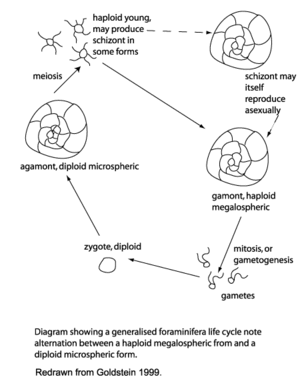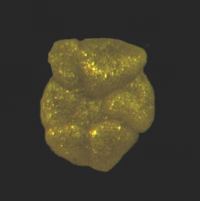Foraminifera
A Microbial Biorealm page on the genus Foraminifera

Classification
Higher order taxa:
Eukaryota; Granuloreticulosea
Species:
Haplophragmoides bradyi, Amphistegina gibbosa, Globorotalia menardii
|
NCBI: Taxonomy Genome |
Description and Significance
Foraminifera fossils appeared during the Early Cambrian period. There are about 4,000 known species. Only 40 of these are planktonic (floating in the upper water column); the rest are benthic (dwelling at the bottom).
Genome Structure
Foraminifera have the largest and most diverse small subunit (SSU) ribosomal RNA genes of any eukaryote. Plasmodiophorids, which have commonly been considered fungi, are related to Foraminifera. Archibald and Keeling (2004) performed genetic analysis on plasmodiophorids and found that Foraminifera are ancestors of these organisms. Other researchers, such as Pawlowski et. al. (2003) have classified species of Foraminifera through genetic analysis. Pawlowski et. al. determined that Xenophyophorea are highly specialized Foraminifera based on their study of SSU rRNA.
Cell Structure and Metabolism

Foraminifera are testate organisms, which means that they have shells (tests). The protoplasm covers the exterior of the test. The simplest shapes are tubes or spheres. The tests are divided into chambers; more chambers are added as the cell grows. There are three basic test compositions: organic, agglutinated, and secreted calcium carbonate. Organic tests are composed of protinaceous mucopolysaccharides such as allogromina. Agglutinated forms usually consist of either randomly accumulated grains or selected grains. The secreted calcium carbonate tests are further subdivided into microgranular, porcelaneous, and hyaline categories. Microgranular tests are composed of crystalline calcite; the grains are subspherical and equidimensional. Porcelaneous tests are comprised of a thick middle layer and two thin outer layers. These tests are made of high magnesium calcite. Hyaline tests add a new layer to the entire organism when a new chamber forms. This test structure is known for its pores.
Foraminifera are single-celled organisms. They can have one or many nuclei. Foraminifera also possess granuloreticulose pseudopodia. These threadlike structures often contain particles of various materials. A distinguishing structure in Foraminifera is the foramen, a hole that connects the wall (septa) between each chamber.
Foraminifera are heterotrophic organisms. Many are opportunistic feeders that prey on other autotrophic and heterotrophic protists. They also consume metazoa, dissolved free amino acids, and bacteria.
The alternation of sexual and asexual generations is common in Foraminifera species. Asexual haploid generations form a large inner chamber known as the proloculus; these are termed megalospheric. The proloculus is smaller when produced by sexual diploid generations; these are termed microspheric. Reproductive cycles tend to be short.
Ecology

Foraminifera are aquatic organisms, found in both freshwater and marine environments. For example, Amphistegina gibbosa inhabit coral reefs and carbonate shelves. Species diversity is highest in tropical areas. Foraminifera are the most prevalent benthic organisms in deep-sea fossil records, but some are planktic. There are many characteristics which influence foraminiferal distribution, such as sediment type, food availability, oxygen levels, and hydrostatic pressure. However, species can tolerate a wide range of unfavorable conditions. Low concentrations of foraminifera in benthic regions may indicate an environment under stress. Foraminifera often form symbiotic relationships with algae.
Although Foraminifera can be predators, they are also prey for some organisms. Worms, crustacea, gastropods, echinoderms, and fish all prey on Foraminifera.
References
Foraminiferal Research at Byrd Polar Research Center.
Hooper Virtual Natural History Museum. Benthic Foraminifera.
Ishman, Scott E. Benthic Foraminifers.
